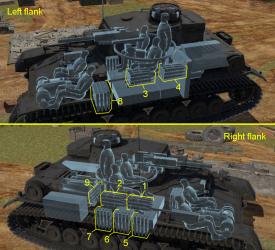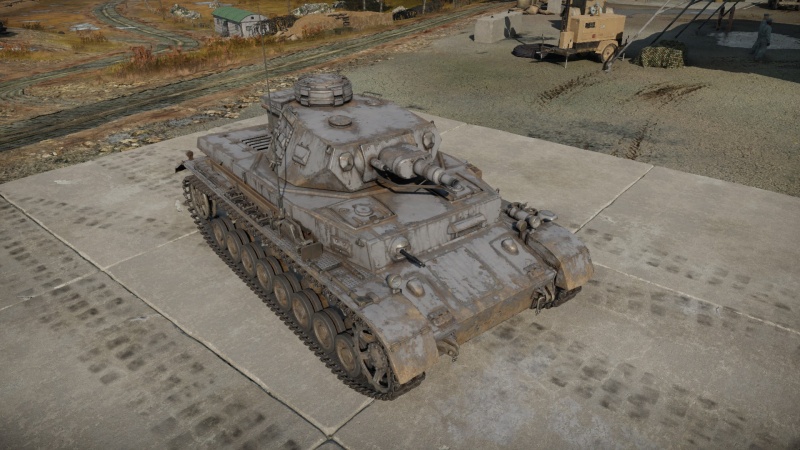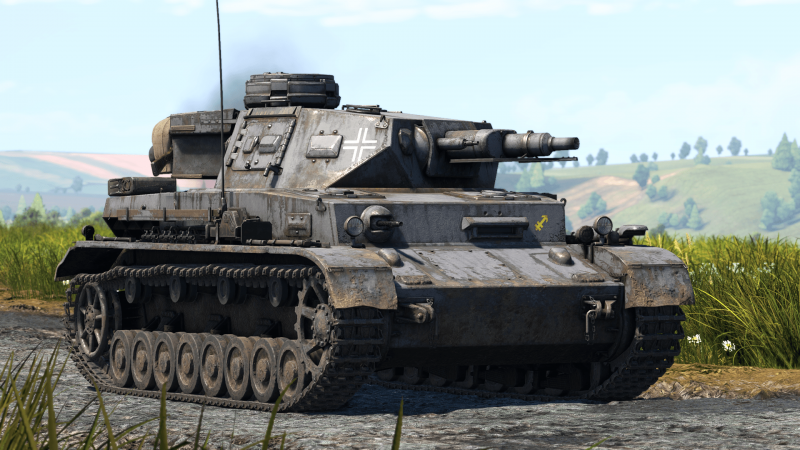Pz.IV F1
| This page is about the German medium tank Pz.IV F1. For other versions, see Pz.IV (Family). |
Contents
Description
The Panzerkampfwagen IV Ausführung F1 (Panzer IV F1) (Sd.Kfz. Index: Sd.Kfz. 161) was the early version of the sixth variant of the Panzerkampfwagen IV medium tank family. Several shortcomings in the Panzer IV E and prior variants were discovered by the time it went into production. The inadequate armour protection was the most apparent. While 50 mm thick frontal armour was planned for the Panzer IV E, it was not implemented by the start of production. When the Panzer IV F went into production in April 1941, it was achievable to install thicker, single-piece armour plates instead of the previous version's two weaker armour plates welded together. On the new Panzer IV F, minor structural improvements to the superstructure and chassis were also planned. Aside from this, the Panzer IV F would function as a support tank. It would be assigned to Panzer divisions to replace vehicles lost in earlier battles. Later, when the purpose of the Panzer III vs. Panzer IV was significantly revised, it was re-designated as the Panzer IV F1. The Panzer III was gradually phased out, and a new variant, the Panzer IV F2, was assigned to anti-tank and infantry support roles.
Introduced in the Closed Beta Test for Ground Forces before Update 1.41, the Panzer IV F1 was almost identical to the Panzer IV E. The sole difference was that the hull frontal armour plate was a single 50 mm plate rather than two separate 30 mm plates welded together. The protection and ammo selections are the same as the previous Panzer IV E variant. It was outfitted with the same short-barrelled 75 mm Kampfwagenkanone (KwK) 37 L/24 tank gun as the previous Panzer IV C, thus gameplay should be identical. However, this concept was modified and significantly changed when the Panzer IV F began to serve as an tank platform as well, resulting in the revised Panzer IV F2 variant.
General info
Survivability and armour
Appearing in 1941 at about the same time as the PzKpfw III Ausf. J, this model saw substantial changes. The basic armour thickness was increased from 30 mm to 50 mm on all front faces (hull, superstructure, turret) and to 30 mm on the sides. The supplementary bolted armour was dropped. The superstructure front was changed back to a single straight plate, and the hull machine gun was changed from the Gimbal mount to a ball mount, Kugelblende 50. In the game, compared to the previous modification Pz.IV E, F1 offers enhanced armour, mostly on the turret, which used to be a "weak spot" on the E variant. Side & Rear hull armour has been improved to 30 mm, and the entire upper front hull is now a single plate of 50 mm steel - while some places are actually weaker, there are no longer any "holes" in the armour easily penetrable by any gun.
Armour type:
- Rolled homogeneous armour
- Cast homogeneous armour (Cupola)
| Armour | Front (Slope angle) | Sides | Rear | Roof |
|---|---|---|---|---|
| Hull | 50 mm (12°) Front plate 20 mm (73°) Front glacis 50 mm (13-58°) Lower glacis |
30 mm | 30 mm (4-14°) | 10 mm |
| Turret | 50 mm (12°) Turret front 50 mm (12-29°) Gun mantlet |
30 mm (23-26°) | 30 mm (14-17°) | 10 mm |
| Armour | Sides | Roof | ||
| Cupola | 30 mm | 10 mm |
Notes:
- Suspension wheels are 15 mm thick while tracks are 20 mm thick.
- The hull underside right above the tracks is 10 mm thick.
Mobility
| Game Mode | Max Speed (km/h) | Weight (tons) | Engine power (horsepower) | Power-to-weight ratio (hp/ton) | |||
|---|---|---|---|---|---|---|---|
| Forward | Reverse | Stock | Upgraded | Stock | Upgraded | ||
| Arcade | Expression error: Unexpected * operator. | 465 | Expression error: Unexpected round operator. | __.__ | |||
| Realistic | 265 | Expression error: Unexpected round operator. | __.__ | ||||
Modifications and economy
Armaments
Main armament
| 75 mm KwK37 | Turret rotation speed (°/s) | Reloading rate (seconds) | |||||||||||
|---|---|---|---|---|---|---|---|---|---|---|---|---|---|
| Mode | Capacity | Vertical | Horizontal | Stabilizer | Stock | Upgraded | Full | Expert | Aced | Stock | Full | Expert | Aced |
| Arcade | 80 | -10°/+20° | ±180° | N/A | 13.3 | 18.4 | 22.4 | 24.8 | 26.4 | 4.29 | 3.80 | 3.50 | 3.30 |
| Realistic | 8.3 | 9.8 | 11.9 | 13.2 | 14.0 | ||||||||
Ammunition
| Penetration statistics | |||||||
|---|---|---|---|---|---|---|---|
| Ammunition | Type of warhead |
Penetration @ 0° Angle of Attack (mm) | |||||
| 10 m | 100 m | 500 m | 1,000 m | 1,500 m | 2,000 m | ||
| K.Gr.rot Pz. | APCBC | 52 | 51 | 45 | 39 | 34 | 30 |
| Hl.Gr 38B | HEAT | 80 | 80 | 80 | 80 | 80 | 80 |
| Sprgr. 34 | HE | 10 | 10 | 10 | 10 | 10 | 10 |
| Hl.Gr 38C | HEAT | 115 | 115 | 115 | 115 | 115 | 115 |
| Shell details | ||||||||||||
|---|---|---|---|---|---|---|---|---|---|---|---|---|
| Ammunition | Type of warhead |
Velocity (m/s) |
Projectile mass (kg) |
Fuse delay (m) |
Fuse sensitivity (mm) |
Explosive mass (TNT equivalent) (g) |
Ricochet | |||||
| 0% | 50% | 100% | ||||||||||
| K.Gr.rot Pz. | APCBC | 385 | 6.8 | 1.2 | 14 | 102.4 | 48° | 63° | 71° | |||
| Hl.Gr 38B | HEAT | 450 | 4.57 | 0.05 | 0.1 | 872.1 | 62° | 69° | 73° | |||
| Sprgr. 34 | HE | 420 | 5.74 | 0.2 | 0.1 | 686 | 79° | 80° | 81° | |||
| Hl.Gr 38C | HEAT | 450 | 4.8 | 0.05 | 0.1 | 875.5 | 62° | 69° | 73° | |||
| Smoke shell characteristics | ||||||
|---|---|---|---|---|---|---|
| Ammunition | Velocity (m/s) |
Projectile mass (kg) |
Screen radius (m) |
Screen deploy time (s) |
Screen hold time (s) |
Explosive mass (TNT equivalent) (g) |
| K.Gr.Rot Nb. | 423 | 6.2 | 9 | 5 | 20 | 50 |
Ammo racks
| Full ammo |
1st rack empty |
2nd rack empty |
3rd rack empty |
4th rack empty |
5th rack empty |
6th rack empty |
7th rack empty |
8th rack empty |
9th rack empty |
Visual discrepancy |
|---|---|---|---|---|---|---|---|---|---|---|
| 80 | 75 (+5) | 69 (+11) | 60 (+20) | 51 (+29) | 43 (+37) | 35 (+45) | 27 (+53) | 4 (+76) | 1 (+79) | No |

Notes:
- Racks disappear after you've fired all shells in the rack.
- To go into battle with flank racks depleted, pack 27 (+53) shells (racks 1 to 7 emptied).
Machine guns
| 7.92 mm MG34 | ||||
|---|---|---|---|---|
| Mount | Capacity (Belt) | Fire rate | Vertical | Horizontal |
| Coaxial | 2,700 (150) | 900 | N/A | N/A |
Usage in battles
Any veteran of the Ausf. C and E should feel right at home in this vehicle. Usage is the same, players should only be careful of some possible new opponents, coming from higher Tiers. In general, it is still an excellent short range corner-cleaner.
The gun is very powerful, with a great rate of fire, but it suffers from low penetration. HEAT shells can be used to solve this issue, but they do a lot less post-penetration damage. The Pz.IV F1 is often capable of annihilating an enemy vehicle with a single AP shell. It has a fair amount of armour as well, however, due to the lack of an actual slope it may seem considerably more fragile than some Soviet vehicles when facing AP shells.
Against most threats, it is often wiser to close in with the enemy vehicle, to make targeting the weakest areas possible, increasing the chance of successful penetration. When engaging vehicles at close range, it is, for example, a good idea to count on the slower turret speed of the Soviet machines, allowing the player to circle around them with ease and deliver devastating shots. Bear in mind that while this tank can easily obliterate any vehicle at its own BR, against higher tier enemies the relatively poor penetration of the gun and very slow shell travel speed can become a problem. Avoiding direct encounters, and using flanking manoeuvres is advisable.
Pros and cons
Pros:
- Fast reload speed for short 75 mm (Great when using HEAT rounds)
- Decent mix of protection and mobility
- Good traverse rate
- Excellent gun depression
Cons:
- Poor AP penetration at range
- Weak side armour
- Huge and weak commander cupola
- Frail engine and ammo rack
- Narrow tracks -> poor performance in soft/sandy terrain (most notable in realistic modes)
- F1 is a bit heavier and slower than previous Pz.IV tanks
History
Development
The Pz.Kpfw. IV's creation, like its predecessor the Pz.Kpfw. III, was devised by Heinz Guderian, where he envisioned a support tank to be used to handle anti-tank guns and fortifications. The Panzer IV was to work alongside the more numerable Panzer III in Panzer Divisions (three company of IIIs and one of IVs) to engage the enemy, giving the role of fighting enemy armoured forces to the Panzer IIIs. As a support tank, the tank was to have the short 75 mm howitzer as its main armament and have a weight limit of 24 tons. MAN, Krupp, and Rheinmetall-Borsig worked on the development of the tanks, but the Krupp's model was selected for further testing.
The chosen model from Krupp, once finished, used a leaf-spring double-bogie system for its suspension, which was chosen instead of both a proposed interleaved suspension and the earlier devised torsion bar suspension system for the sake of faster production. The vehicle held five crew members, the commander, gunner, loader, radio operator (and hull machine gunner), and driver. Though it looked symmetrical, the Panzer IV turret was actually offset to the left of the chassis centre line a bit while the engine was also offset to the right, this was to allow the torque shaft to turn the turret. The offset also meant that most of the ammo is held on the right side of the tank in storage areas. The Panzer IV was then accepted into service and production began in 1936.
Panzer IV Ausf. F1
After the Battle of Poland and France, the deficiencies of the Ausf. C variant saw it being upgraded on October 1940 to the Ausf. E. Despite the new upgrades, the Panzer IV was upgraded again to refine its detail with the Panzer IV Ausf. F in April 1941. Still retaining the KwK 37 L/24 75 mm howitzer gun, but with now a full 50 mm thick glacis plate and an increase of side armour to 30 mm. The tracks are also widened from 380 to 400 mm to balance the increased weight from the Ausf. C's 18 tons to the Ausf. F 22 tons.
The Ausf. F was the main Panzer IV variant during the start of Operation Barbarossa, but was soon found to be terribly outgunned by the appearance of the Soviet T-34 and KV-1 tanks. The short 75 mm howitzer was inadequate to deal with these new tanks at all. All was not lost though, as in the weeks before Barbarossa, a proposal was made to upgrade the Panzer IV with a new gun to increase its firepower, with the new 75 mm Pak 40 anti-tank gun. The resulting gun was the KwK 40 L/43 and up-gunned the Panzer IV Ausf. F. The Ausf. F was then renamed to F1 for the variants retaining the shorter 75 mm howitzer, and Panzer IV Ausf. F2 for the variants with the more lethal 75 mm KwK 40 L/43 gun.
| Archive of the in-game description | |
|---|---|
|
The Pz. IV Ausf. F tank was the result of analysis of previous variants' combat experience in Poland and France. The thickness of the front armour on the turret and hull was increased to 50 mm. The single-hinged hatches on the sides of the turret were replaced with double-hinged ones. The thickness and arrangement of viewports were modified. The front hull was straightened once again. The directional machine gun received a new Kugelblende 50 ball mount. The ammunition for the machine guns (both the gun paired with the cannon and the directional gun) was increased to 3,000 rounds. Since the hull's weight was 48% greater than that of the Ausf. E variant, the vehicle received new 400-mm-wide tank treads instead of the 360 mm treads used earlier. Additional ventilation holes were located in the roof of the engine compartment and in the covers over the transmission hatch. The design and placement of the engine and turret rotation motor were modified. All of these improvements were intended to increase the safety of the crew and the usability and serviceability of the vehicle. The Krupp-Gruson, Vomag, and Nibelungenwerke companies manufactured this tank from April 1941 to March 1942. A total of 437 were produced. Beginning in April 1942, the tank was designated Pz.Kpfw. IV Ausf. F1, since it was the basis for the design of the Pz.Kpfw. IV Ausf. F2, which included a new 75 mm 7,5 cm KwK 40 gun with a long 43-caliber barrel. Pz.Kpfw. IV Ausf. F1 vehicles fought in Africa, on all parts of the Eastern Front from 1941 to 1944, and in Operation Citadel. This variant was supplied to Germany's allies: Hungary, Croatia, Turkey, and Spain. Captured Pz.Kpfw. IV Ausf. F tanks were eagerly used by the Red Army. | |
Media
- Skins
- Sights
See also
Links to the articles on the War Thunder Wiki that you think will be useful for the reader, for example:
- reference to the series of the vehicles;
- links to approximate analogues of other nations and research trees.
External links
Paste links to sources and external resources, such as:
- topic on the official game forum;
- other literature.
| Germany medium tanks | |
|---|---|
| Pz.III | Pz.III B · Pz.III E · Pz.III F · Pz.III J · Pz.III J1 · Pz.III J1 TD · Pz.III L · Pz.III M · Pz.III N |
| Pz.IV | Pz.IV C · Pz.IV E · Pz.IV F1 · Pz.IV F2 · Pz.IV G · Pz.IV H · Pz.IV J · Pz.Bef.Wg.IV J |
| Pz.V | VK 3002 (M) · Panther A · Panther D · Panther F · Panther G · Ersatz M10 · Panther II |
| M48 upgrades | M48A2 G A2 · M48 Super |
| Leopard 1 | Leopard I · Leopard A1A1 · Leopard A1A1 (L/44) · Leopard 1A5 · C2A1 · Turm III |
| Leopard 2 | PT-16/T14 mod. · Leopard 2K · Leopard 2AV |
| Leopard 2A4 · Leopard 2 (PzBtl 123) · Leopard 2A4M · Leopard 2 PL · Leopard 2A5 · Leopard 2 PSO · Leopard 2A6 · Leopard 2A7V | |
| Trophies | ▀M4 748 (a) · ▀T 34 747 (r) |
| Other | Nb.Fz. · KPz-70 |
| USA | mKPz M47 G · M48A2 C |
| USSR | ◊T-72M1 |






